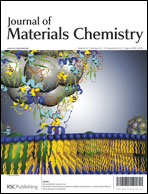Mechanism of interaction between colloids and bacteria as evidenced by tailored silica–lysozyme composites†
Abstract
The ever increasing antibiotic resistance levels in pathogenic and non-pathogenic bacteria have boosted the search for effective controlling methods of bacterial infections. In this context, we prepared colloidal silica–lysozyme composites to evaluate the interaction between these structures and bacteria. Lysozyme was chosen since it is a protein that holds bactericidal properties and that, in the reaction process, acts as a catalyst which favors silica hydrolysis and condensation. The high entrapment yield of lysozyme in the silica cage (approximately 95%) does not change the secondary structure of the protein resulting in a material with superior bactericidal properties. The antimicrobial differences when silica–lysozyme composites are tested against Escherichia coli and Staphylococcus aureus are used to propose an interaction mechanism between colloids and bacteria. Bactericidal properties of the composites are attributed to the ultra-structural organization of the composite which, due to the positive surface charge, is attracted by the negative bacterial cell wall while lysozyme is delivered.


 Please wait while we load your content...
Please wait while we load your content...